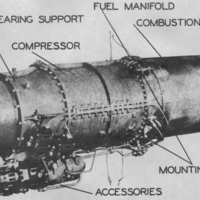

However, as BB 1 moves toward the base, the pressure ratio of the trailing shock wave increases, making it more difficult for the scavenged air and the low velocity air in the boundary layer to overcome the pressure rise of the shock wave and flow downstream. Thus the line BB 1 moves toward the base. Some of the air is removed from the separated region, causing the angle of turning at A to be increased and the pressure in the separated region to be decreased. The steady-state equilibrium of base pressure and the position of BB 1 line is reached due to the scavenging effect of the outside flow on the mass of the separated region. Inside the separated region a slow circulating motion exists due to the viscosity of air. The velocity profiles between A and B are the same as those which are found at boundaries of a supersonic jet issuing into ambient air. If flow is laminar, transition begins at a certain point between A and B after passing through the region of the trailing shock, the flow becomes completely turbulent in the wake. The base pressure is lower than the static pressure at A therefore a small fan of expansion wavelets originates at this point A. The physical phenomena of flow near the base which is affected by viscosity of the fluid are as follows: the flow separates at the rear end of the body consequently, the separated region Ad 1 A 1 is formed, and because of this separated region the static pressure along AB is approximately constant.


 0 kommentar(er)
0 kommentar(er)
